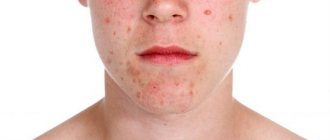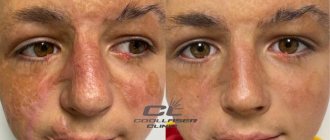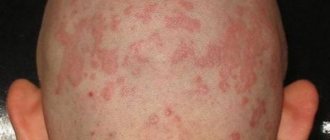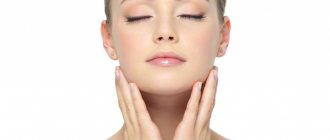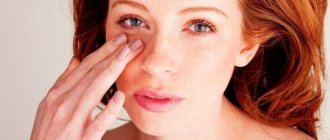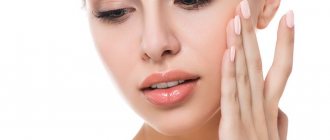Causes
There are many reasons that provoke the detachment of particles of the scalp, let’s consider the most common:
- Metabolic disorder is the main cause of dandruff; because of this pathology, the body is more vulnerable to the action of pathogenic factors.
- Hormonal imbalances are a fairly common cause of seborrhea in women.
- Various diseases - for example, disorders of the gastrointestinal tract or endocrine system, bronchopulmonary diseases, neurological disorders, low immunity;
- Hereditary predisposition is a cause that cannot be eliminated.
- Disturbed functioning of the sebaceous glands.
- Poor nutrition, hypovitaminosis.
- Overstrain of a mental or physiological nature.
- A fungus caused by Pityrosporum Ovale - yeast-like fungi, elements of the healthy microflora of the scalp.
- External negative effects on the scalp - abuse of hair dryers, curling irons, frequent coloring;
- Ignoring a hat in winter or wearing a warm headdress in the heat;
- Poor scalp hygiene. However, this reason occurs only in advanced cases when a person refuses to wash his hair at all.
Why does dandruff appear in children?
Not only adults, but also children of different ages suffer from dandruff. In infants, this is due to insufficient development of the sebaceous glands. Sometimes it appears during breastfeeding in the form of an allergy to foods consumed by the mother. It can also appear due to the wrong bathing product or shampoo.
Dandruff is also common in teenagers. This is explained by the fact that during puberty, the sebaceous glands work in an enhanced mode and produce too much sebum.
Types of dandruff
Dry dandruff
– caused by decreased sebum secretion (too dry skin). In this case, dandruff flakes are small in size, easily come off the skin, and a “powdered” effect is observed on the hair. Most often they are located along the entire length of the hair; lesions form quite rarely.
Oily dandruff
– this disorder occurs with increased sebum secretion. Dandruff flakes are large, stick together and attach to the hair. They peel off more easily than dry ones. With such dandruff, the hair quickly becomes oily and the patient feels constant itching.
Characteristic symptoms
Regardless of the cause, the symptoms of the disease are always typical:
- white or yellow scales of the epidermis on the skin and hair. In this case, dandruff may take the form of small flaking scales or large crusts that cover large areas of the head;
- itching The symptom is characteristic of both mild and severe degrees of the disease;
- signs of skin irritation. A characteristic manifestation of a severe form of the disease.
Sometimes dandruff reveals itself not as a set of signs, but only as one symptom, and it can be difficult to independently determine the degree of development of the disease.
Effective treatments
Dandruff is dry, flaky scalp cells that cannot be ignored. This disorder may indicate that the patient has seborrheic dermatitis of the scalp. Let's consider the most effective methods of combating this disease.
Special diet
Trichologists believe that the appearance of dandruff is not necessarily associated with illness and stress. Reasons may include:
- improper care of hair and scalp;
- excessive consumption of sweet and fatty foods.
A balanced diet can help get rid of dandruff without risking your health.
Antifungal agents
I can overcome these violations with special means. Most often, experts prescribe antifungal tablets, such as Mycozoral, Nizoral and Nystatin. Remember that any medications should only be prescribed by a doctor, indicating the dosage and characteristics of use.
Special procedures
Physiotherapeutic procedures to help get rid of dandruff:
Darsonvalization
- a method that involves influencing the scalp using electrical impulses. This method will help well in the treatment of oily dandruff. The device used during the procedure improves metabolic processes and blood circulation. The duration of one session reaches 8 minutes.
Cryomassage - this therapy is carried out using liquid nitrogen or ice. This procedure will be most effective for oily dandruff and seborrheic dermatitis. Ice is applied to the infected areas and then a scalp massage is performed. Nitrogen is applied in a thin layer to the scalp with a cotton swab. The session lasts no more than 10 minutes, as there is a risk of getting a cold burn.
Mesotherapy
– one of the most effective methods of treating dandruff. The procedure is carried out as follows: the skin of the head and neck is pricked with special medications, which include individually selected substances.
Shampoos, balms and lotions
Mild forms of seborrhea and dandruff can be cured not only by physiotherapeutic procedures, but also by medications. For example, shampoos containing ketoconazole, which eliminates flaking and relieves itching. Sulfur ointment, also used for various types of fungus, may help you. Products containing zinc, bifonazole or tar have good properties in the treatment of seborrhea.
The structure of the skin and its appendages
Skin is a part of the body that performs many functions:
- Protective. A function that protects the body from harmful influences - chemical, mechanical, hypothermia and overheating, etc.
- Respiratory. The surface of the skin makes 2% of the total “breathing” of the entire human body.
- Regulatory. Mineral and water balances, thermoregulation (due to sweating) are carried out by this function.
The skin consists of three components:
- Epidermis is the outer layer.
- The dermis, that is, the skin itself, is an intermediate layer (connective tissue). The dermis is the support for blood vessels, nerves and skin appendages.
- The hypodermis is the layer that lies deeper than the others.
Hair, sebaceous, sweat glands are skin appendages on the head.
Epidermis
Several layers make up the epidermis. Cells originate in the basal layer, some of them continuously move towards the stratum corneum, changing their appearance along the way and, at the final stage, losing their nucleus. By the end of the movement, these cells become keratinized, nuclear-free scales that form the stratum corneum.
These scales are constantly replaced by others that rise from the basal layer. This is how skin regeneration or renewal occurs. Melanin, which determines the color of hair and skin, is produced by cells located in the cuticle. And the immune system of the skin is macrophages.
Dermis
A set of bundles of connective tissue and elastic fibers, which is the dermis, helps maintain the shape of the skin, that is, stretch and contract without visible changes.
Here are located:
- nerves;
- hair follicles;
- vessels;
- sweat and sebaceous glands.
Sweat creates comfortable thermoregulation and removes dangerous substances from the body. The sebaceous glands have an equally important function. They produce sebum, which protects against hypothermia and drying out, and prevents the dermis from cracking.
Hypodermis
The layer that is located deeper than the others. This is where blood vessels and nerve trunks are located. The thickness of the hypodermis on the head is about 2 mm.
What not to do?
Absolutely forbidden:
- Scratch your head. Itchy dandruff can be very uncomfortable, but scratching and scratching your skin will make the problem worse. Through the slightest damage, infections can easily penetrate, which can lead to the formation of pustules;
- Use alcohol-based products, as they greatly dry out the skin;
- Dye your hair and use other chemical hair products;
- Use metal combs; the teeth of such a comb can damage the scalp and cause more dandruff to appear.
- Keep the use of hair dryers and curling irons to a minimum.
Possible complications
In addition to the psychological discomfort that inevitably arises with the appearance and development of the disease, dandruff can also cause a number of complications, such as:
- sebopsoriasis - scaly plaques appear not only on the head, but also in the eyebrow area, on the body;
- hair loss - hair follicles lose access to oxygen, so the hair weakens, splits, and falls out over time;
- pyoderma - purulent skin lesions: boil, sycosis, folliculitis, etc.;
- atheroma, or cyst of the sebaceous gland - that is, a formation that occurs due to blockage of the duct of this gland.
A timely visit to a dermatologist or trichologist will help to avoid the development of complications. Depending on the factor in the development of the disease, consultation with specialized specialists - an endocrinologist, gastroenterologist, etc. - may be required.
Lotions for dry and oily seborrhea
Olga Green also recommends using lotions. Let's look at the most effective moisturizers that can quickly and effectively get rid of dry dandruff and oily dandruff.
Yves Rocher anti-seborrhea lotion contains pomegranate, which is very beneficial for the scalp. It eliminates itching and inflammation, helps normalize pH, and has a pronounced antiseptic effect. Consists mainly of plant extracts. Its average cost reaches 600 rubles.
Anti-Dandruff Lotion Subrina Professional anti-dandruff lotion is an effective remedy that helps fight itching and inflammation. It moisturizes the skin and normalizes its Ph. Octopirox not only fights dandruff, but also helps prevent its reappearance. Tea tree oil has a disinfecting effect.
How to remove dandruff without the intervention of a cosmetologist?
The most common means of control is medicated shampoos. They differ from ordinary ones in composition and contain:
- antifungals (climbazole and ketoconazole);
- zinc compounds;
- birch tar derivatives;
- salicylic acid.
It makes sense to use medicated shampoos at the initial stage of development of the disease, when it does not yet cause significant discomfort. In addition to shampoos, you can use cosmetic masks with a similar composition.
However, you should select these care and treatment products on the advice of a specialist. This approach will eliminate allergic reactions to the components of the shampoo or mask, achieve lasting results and save on treatment.
Oily seborrhea. Forms
Having figured out how to determine whether dandruff is dry or oily, let's move on to the varieties of the latter. When it appears, the hair seems constantly wet and by the end of the day it sticks together in unkempt clumps, it has an unhealthy shine. Severe itching and increased hair loss are possible. In extreme cases, this can lead to baldness. In the absence of proper treatment, there is a risk of developing furunculosis and abscess. Sebaceous cysts also often appear on the skin, which look like white point formations.
With a thick form of oily seborrhea, there is an expansion of the mouths of the sebaceous glands, which is expressed in a grayish-brown tint of the scalp. In patients suffering from this form of the disease, the secretion of the sebaceous glands and exfoliating epidermal cells form oily, thick dandruff, which clogs the excretory glandular ducts and sticks to the hair. If you squeeze the mouth of the follicle, a viscous secretion is observed. It is also possible to form an atheroma - an epidermal cyst filled with a liquid of a pasty consistency. Atheromas can become inflamed and cause suppuration. This condition manifests itself in increased body temperature and hyperemia of the affected skin area. After opening the lesion, a scar remains.
A thick form of oily seborrhea often occurs in males during adolescence, but goes away by the age of 25-28. In most cases, it does not lead to baldness, but can cause the development of furunculosis.
Diagnosis of the problem in the clinic
Before you begin treating dandruff, you need to determine its causes. All questions can be accurately answered only after a detailed diagnosis.
At the initial examination, the SM-Cosmetology doctor determines the size and nature of the scales, examines the scalp to assess color changes, the presence of plaques and scratches. In addition to a visual examination, the doctor refers the patient to a biochemical blood test, the results of which will allow us to look at the problem more broadly and, possibly, identify hidden causes.
If there is any doubt about the diagnosis, a histological examination of a skin biopsy is indicated, in which biological material is taken from the affected area and examined under a microscope.

